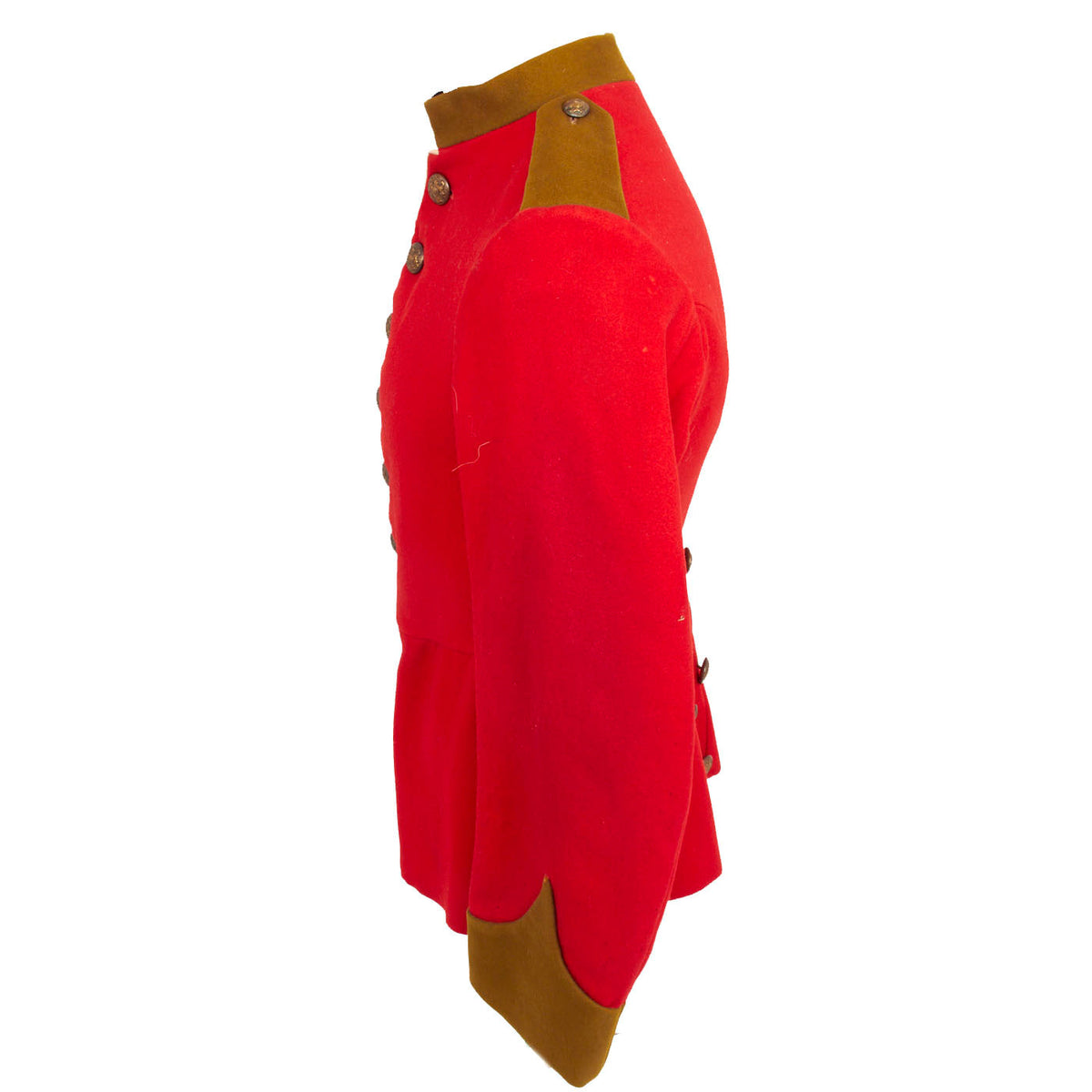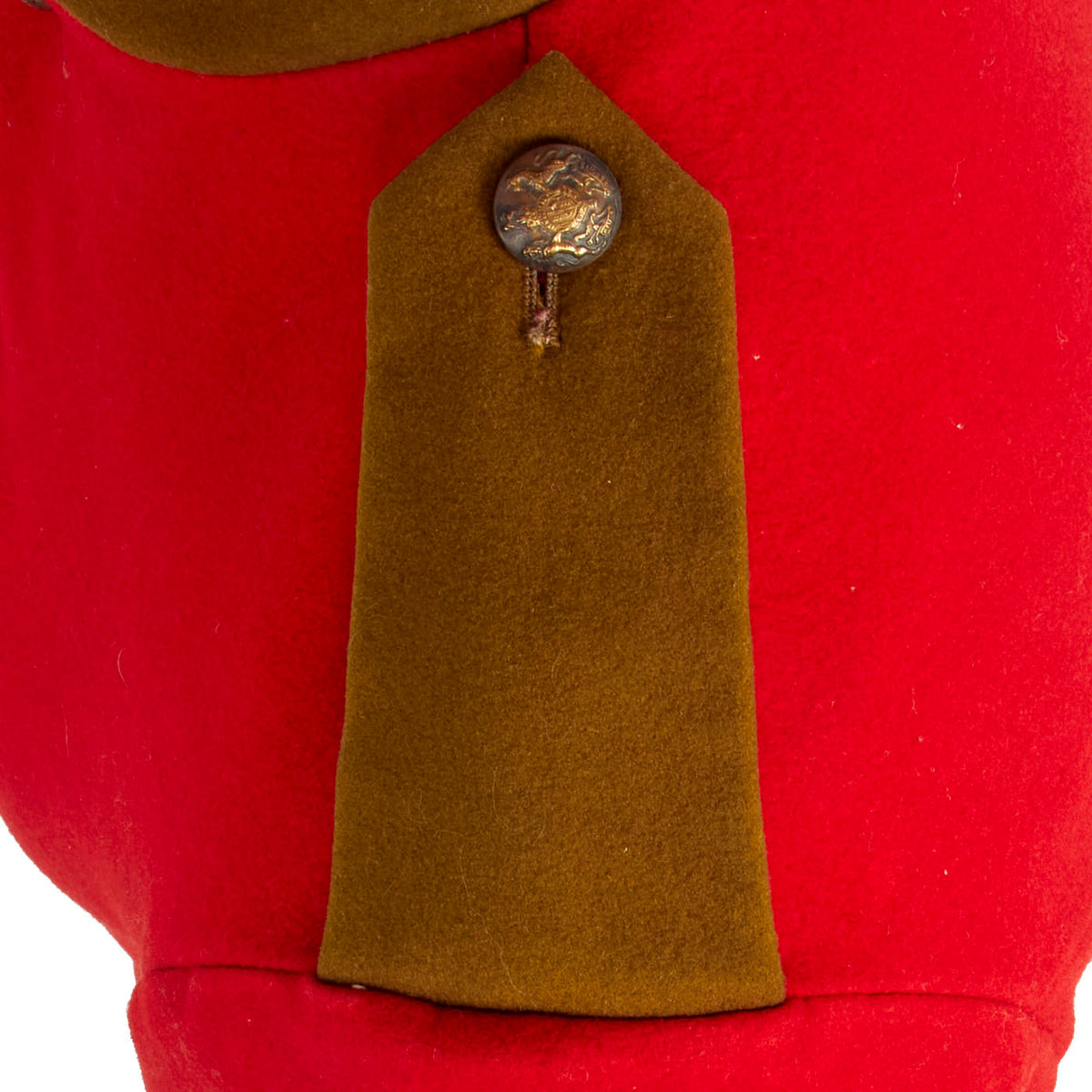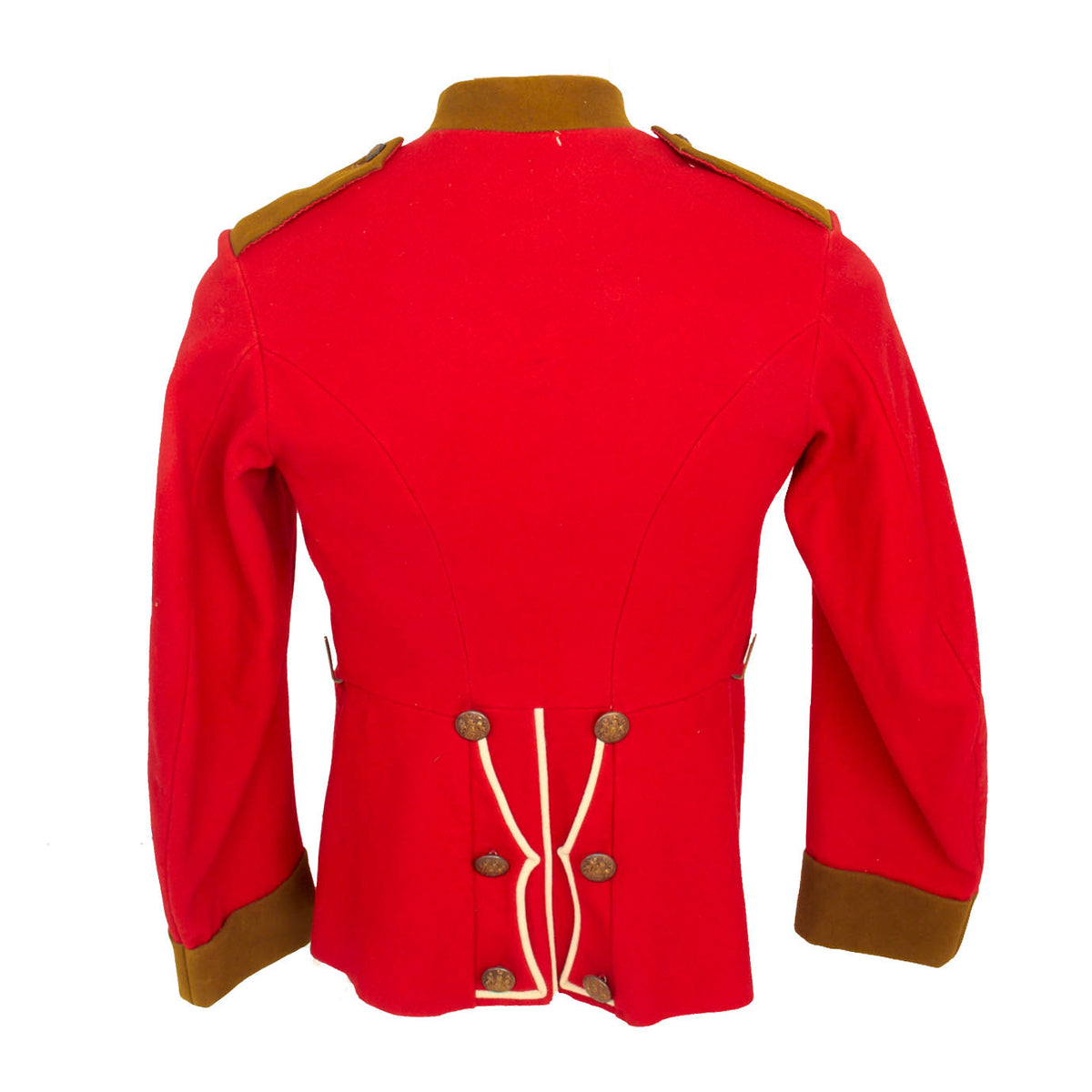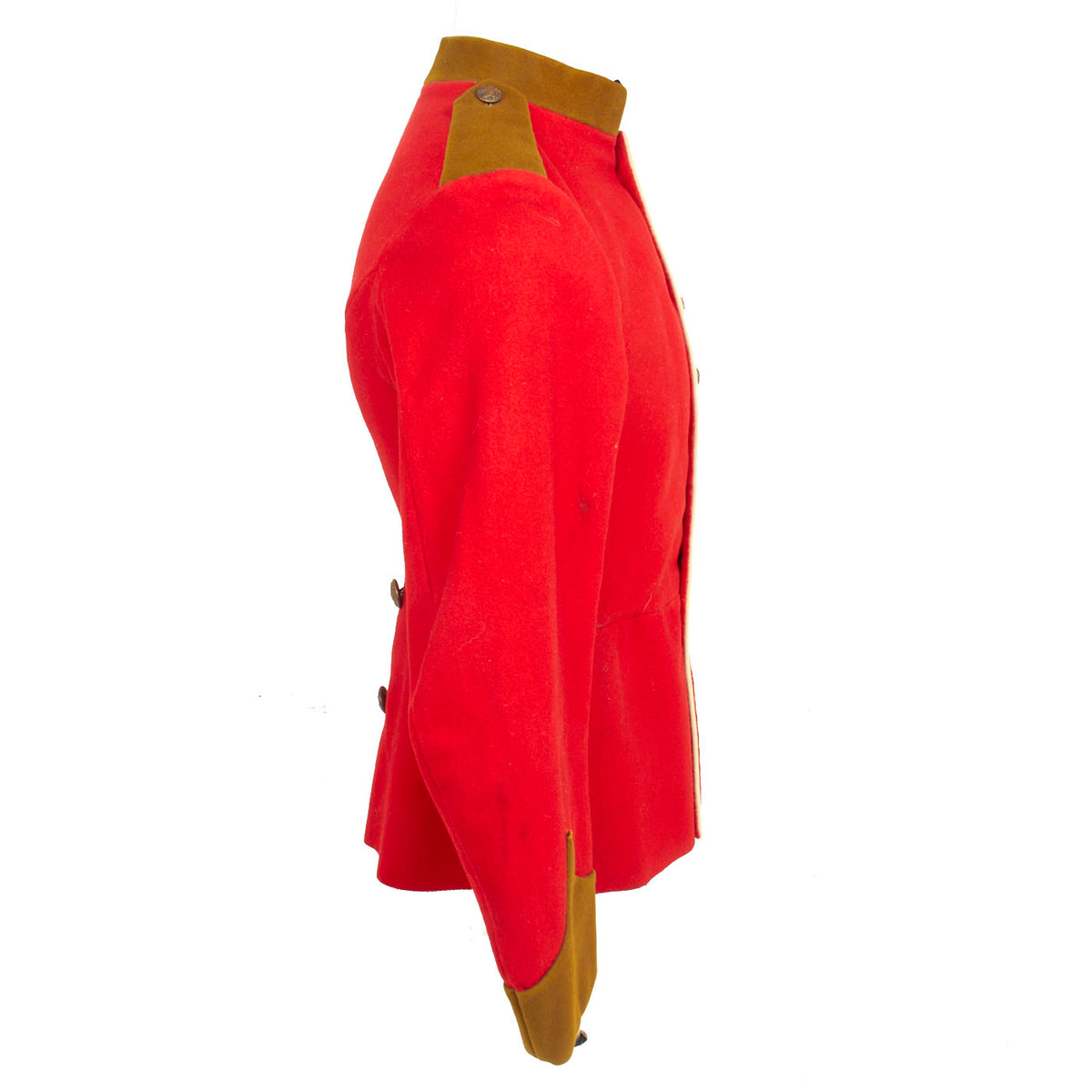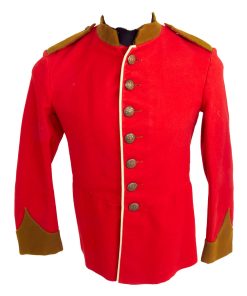Original British Pre-WWI / WWI Era Durham Light Infantry Scarlet Tunic – Broad Arrow Marked Original Items
$ 225,00 $ 90,00
Original Item: Only One Available. Red coat (also spelled as “redcoat”) or scarlet tunic was a military garment used widely, though not exclusively worn, by most regiments of the British Army, Royal Marines, and some colonial units within the British Empire, from the 17th to the 20th centuries. The scarlet tunic continues to be used into the 21st century, with several armed forces of the Commonwealth of Nations adopting them as their full dress and mess dress uniforms. The uniform and term “redcoat” may have originated in 16th century Tudor Ireland as a derogatory term for the British, as British soldiers in Lord Lieutenant of Ireland’s army wore red coats, the first time English and Scottish soldiers under English command and later British collectively had a red uniform. The term was then brought to America and Europe by Irish emigrants.
From the mid-17th century to the 19th century, the uniform of most British soldiers (apart from artillery, rifles and light cavalry) included a madder red coat or coatee. From 1873 onwards, the more vivid shade of scarlet was adopted for all ranks, having previously been worn only by officers, sergeants and all ranks of some cavalry regiments.
The tunic is a fine example of an “Other Ranks” scarlet coat and is constructed of kersey wool with an off white kersey wool lining. The coat is secured by 5 General Service buttons with matching buttons on the shoulders and the tails on the back. The inside right shoulder is Broad Arrow marked “WD” for War Department and another “D” beneath the stamping.
Comes more than ready for further research and display.
Approx. Dimensions:
Collar to shoulder: 9.5”
Shoulder to sleeve: 23”
Shoulder to shoulder: 16”
Chest width: 16”
Waist width: 15″
Hip width: 18”
Front length: 26″
The Durham Light Infantry (DLI) was a light infantry regiment of the British Army in existence from 1881 to 1968. It was formed in 1881 under the Childers Reforms by the amalgamation of the 68th (Durham) Regiment of Foot (Light Infantry) and the 106th Regiment of Foot (Bombay Light Infantry) along with the Militia and Volunteers of County Durham.
The regiment served notably in the Second Boer War, World War I and World War II, the Korean War and the Indonesia–Malaysia confrontation. During times of peace it had duty in India, China, West Germany and Cyprus.
In 1968, the regiment was amalgamated with the Somerset and Cornwall Light Infantry, the King’s Own Yorkshire Light Infantry and the King’s Shropshire Light Infantry to form The Light Infantry, which again amalgamated in 2007 with the Devonshire and Dorset Regiment, the Royal Gloucestershire, Berkshire and Wiltshire Regiment and the Royal Green Jackets to form a new large regiment, The Rifles, which continues the lineage of the regiment.
The 1st battalion and the company from the 2nd left South Africa for India on the SS Assaye at the end of October 1902, and on 15 November both battalions met at Calicut, before the 2nd battalion, which had been guarding Boer prisoners, left for Britain. The 1st battalion was stationed at Wellington in Madras Presidency.
In 1908, as part of the Territorial Forces Act, the 3rd and 4th battalions exchanged numbers and were recast as the 3rd (Reserve) and 4th (Extra Reserve) battalions in a draft finding role. The 1st to 5th Volunteer battalions were renumbered as the 5th to 9th battalions Durham Light Infantry of the Territorial Force. The 5th formed part of the York and Durham Brigade and the 6th–9th battalions formed the Durham Light Infantry Brigade of the Northumbrian Division (eventually the 150th (York and Durham) Brigade and 151st (Durham Light Infantry) Brigade respectively of the 50th (Northumbrian) Division when the territorial formations were given numbers in May 1915). The 5th Battalion was based at Paradise Row in Stockton-on-Tees, while the 6th Battalion was based at Union Street in Bishop Auckland, the 7th Battalion was based at Livingstone Road in Sunderland, the 8th Battalion was based at Gilesgate in Durham and the 9th Battalion was based Burt Terrance in Gateshead (all since demolished). In 1911, the 1st battalion took part in the Delhi Durbar, receiving new colours from the King.
Fast Shipping with Professional Packaging
Thanks to our longstanding association with UPS FedEx DHL, and other major international carriers, we are able to provide a range of shipping options. Our warehouse staff is expertly trained and will wrap your products according to our exact and precise specifications. Prior to shipping, your goods will be thoroughly examined and securely secured. We ship to thousands clients each day across multiple countries. This shows how we're dedicated to be the largest retailer on the internet. Warehouses and distribution centres can be located throughout Europe as well as the USA.
Note: Orders with more than one item will be assigned a processing date depending on the item.
Before shipping before shipping, we'll conduct a thorough inspection of the items you have ordered. Today, the majority of orders will be delivered within 48 hours. The delivery time will be between 3-7 days.
Returns
The stock is dynamic and we cannot completely manage it because multiple stakeholders are involved, including our factory and warehouse. So the actual stock may alter at any time. It's possible that you may not receive your order once the order has been made.
Our policy is valid for a period of 30 days. If you don't receive the product within 30 days, we are not able to issue a refund or an exchange.
You can only return an item if it is unused and in the same state as the day you received it. You must have the item in its original packaging.
Related products
Uncategorized
Uncategorized
Uncategorized
Uncategorized
Angolan Rebel 1970s era 60mm Inert Display Mortar from Angolan Civil War Original Items
Uncategorized
Uncategorized
Uncategorized
Uncategorized
Uncategorized
Uncategorized
Uncategorized
Uncategorized
Uncategorized
Uncategorized
Band of Brothers ORIGINAL GERMAN WWII Le. F.H. 18 10.5cm ARTILLERY PIECE Original Items
Uncategorized
Australian WWII Owen MK1 Machine Carbine SMG Custom Fabricated Replica with Sling Original Items
Uncategorized
Uncategorized
Uncategorized
Armored Burgonet Helmet & Polearm from Scottish Castle Leith Hall Circa 1700 Original Items
Uncategorized
Uncategorized
Uncategorized
Uncategorized
Armoured Fighting Vehicles of the World: AFVs of World War One (Hardcover Book) New Made Items


